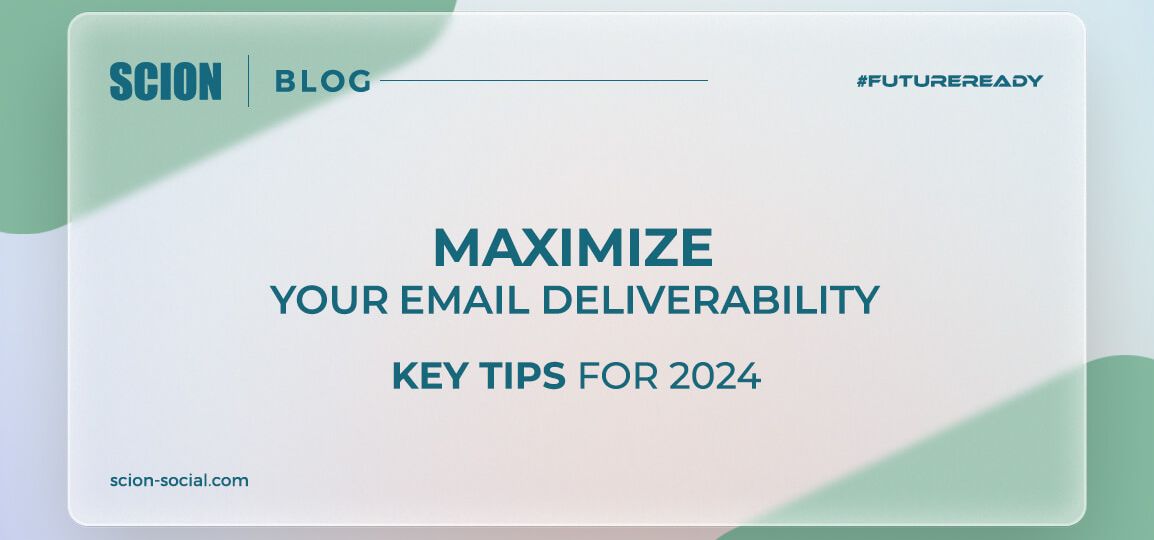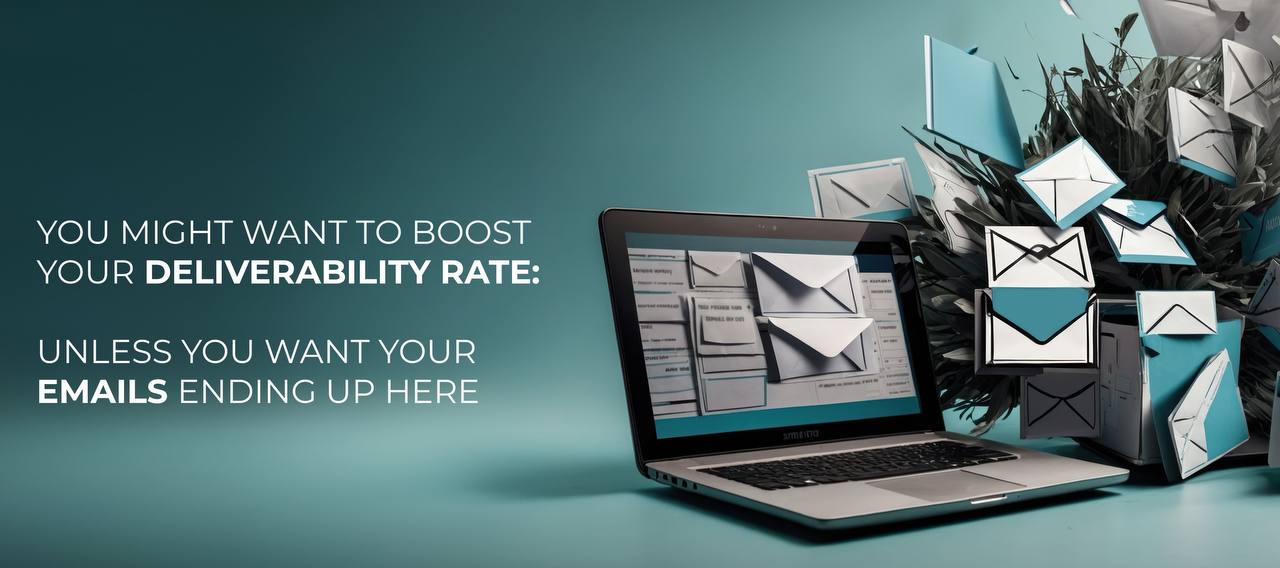
Maximize Your Email Deliverability: Key Tips for 2024
What is Email deliverability?
Simply put, it is the ability of an email to successfully reach the intended recipient’s inbox. It’s a crucial metric for email marketers because it directly impacts the effectiveness of their campaigns. If emails don’t make it to the inbox, they can’t be seen or engaged with, rendering the entire effort futile- like setting up a candy shop in the middle of the desert. The importance of high email deliverability cannot be overstated. 83% of emails get lost! This hurts sales and damages your sender reputation. Boost email deliverability to reach inboxes and win. Want to know how? Jump right to the section(s):
83% of emails get lost! This hurts sales and damages your sender reputation. Boost email deliverability to reach inboxes and win. Want to know how? Jump right to the section(s):- 5 Email Deliverability Killers
- What Actually Work
- Methods for Testing Email Deliverability
- Measuring Email Marketing Success: Key Metrics
- Tools and Platforms
- Resources for Ongoing Education
- Industry Trends to Look Out For
5 Email Deliverability Killers:
Watch out for these factors that impact your email deliverability (and potentially your conversion rate).- Dirty Email List
- Authentication and Spam Traps
- Spammy Content
- Reputation
- Bad ESPs
Let’s Explore What Actually Works
1. Build a Permission-Based Email List One of the most crucial factors for high email deliverability is having a permission-based email list of subscribers who have explicitly opted-in to receive your emails. Sending unsolicited bulk emails to purchased lists or harvested addresses is considered spam and will severely damage your sender’s reputation with email providers. To build a quality, permission-based list:- Use opt-in forms on your website to collect email signups from interested visitors.
- Offer incentives like discounts, content, or resources in exchange for an email signup.
- Make sure your opt-in process and email policy are clear and transparent.
- Consider using a double opt-in process where subscribers must confirm their email address.
- Only add addresses of those who have definitively given permission to receive your emails.
2. Authenticate Your Email with SPF, DKIM, and DMARC
- SPF (Sender Policy Framework): Stops email spoofing by verifying authorized email servers for your domain- like a whitelist in (DNS) Domain Name System.
- DKIM (DomainKeys Identified Mail): Adds a digital signature to emails, ensuring content hasn’t been altered in transit. Think of it like a tamper-proof seal.
- DMARC (Domain-based Message Authentication, Reporting & Conformance): Builds on SPF & DKIM. The primary role of DMARC is to ensure that emails claiming to be from a particular domain are indeed authorized to do so. It builds upon the existing SPF and DKIM protocols to provide a more robust authentication framework for email senders and receivers. It achieves this by allowing domain owners to publish a DMARC policy that specifies how email receivers should handle messages that fail authentication checks. This policy can instruct receivers to reject, quarantine, or simply report on non-compliant messages.
3. Optimize your email content for deliverability
ISPs use sophisticated filters to block spam, and your email content can make or break your chances of reaching inboxes. To ensure delivery, optimize your content:- Balance HTML and text (The widely accepted best practice is to maintain a composition of 60% text and a maximum of 40% image coverage, ensuring a minimum of 400 characters of text)
- Avoid spammy wording
- Use relevant images with alt text
- Keep CTAs clear and concise
4. Maintain a Good IP and Domain Reputation
Email deliverability heavily relies on the reputation of your sending IP address and domain. ISPs and email providers constantly monitor the reputation of senders to protect their users from spam and malicious emails. One such tool that efficiently runs through the checklist is called Sender Score. Here are more ways to build and maintain a positive reputation, you should:- Monitor Bounce Rates: High bounces indicate list hygiene issues. Regularly remove invalid addresses to stay below industry standards.
- Track Spam Complaints: Minimize complaints with clear unsubscribe options, segmented lists, and avoiding unsolicited emails.
- Warm Up New IPs: Gradually increase email volume when using a new IP to avoid triggering spam filters.
- Authenticate Emails: Implement SPF, DKIM, and DMARC to prove legitimacy and prevent spoofing.
- Monitor Blacklists: Check if your IP or domain is blacklisted. If so, follow delisting procedures to restore your reputation.
5. Choose an Email Service Provider for High Deliverability
Choosing the right ESP is key. Look for providers with strong deliverability practices and infrastructure. Here’s what to consider:- Shared vs. Dedicated IPs: Dedicated IPs offer better deliverability but require more management.
- Whitelisting & Feedback Loops: Reputable ESPs have these to ensure a good sender reputation.
- Deliverability Monitoring: Track bounce rates, spam complaints, and inbox placement to identify and fix issues.
- Reputation Management Services: Helpful for high-volume senders or those in regulated industries.
- Technical Support: Choose an ESP with a knowledgeable team to guide you on best practices and address deliverability problems.
Methods for Testing Email Deliverability
Email deliverability is a critical aspect of any successful email marketing campaign. Before hitting the send button, it’s crucial to ensure that your emails will land in the recipient’s inbox and not get caught in spam filters or blocked entirely. Here are some proven tools and methods to test your email deliverability:- Email Testing Services: Tools like GlockApps, Litmus, and Email on Acid test how your emails render across different platforms and check for spam triggers.
- Seed Lists: Track delivery to various email providers (ESPs) and internet service providers (ISPs) by adding seed list email addresses to your mailing list.
- Feedback Loops: Get notified when recipients mark emails as spam to identify content or sender reputation issues.
- Email Analytics: Monitor metrics like delivery rates, open rates, and bounces to spot potential deliverability problems.
- Authentication & Reputation Monitoring: Use SPF, DKIM, and DMARC protocols and monitor sender reputation to improve email authentication.
- Content Filtering:
- Review content for spammy words, excessive HTML, or suspicious links.
- Craft clear and concise subject lines.
- Consider plain text formatting for important emails.
- Test email content before sending.
- Monitor engagement metrics to identify content issues.
Measuring Email Marketing Success: Key Metrics
In the dynamic email marketing landscape, measuring success is crucial to understanding the effectiveness of your campaigns and making data-driven decisions.- Open Rates: Open rates indicate the percentage of recipients who opened your email. High open rates suggest that your subject lines and sender’s reputation are resonating with your audience.
- Click-Through Rates (CTRs): CTRs measure the percentage of recipients who clicked on one or more links within your email. This metric is a strong indicator of the relevance and persuasiveness of your email content, as well as the effectiveness of your call-to-action (CTA).
- Conversion Rates: Conversion rates track the percentage of recipients who completed a desired action, such as making a purchase, signing up for a service, or downloading a resource.
- Return on Investment (ROI): ROI calculations compare the revenue generated from an email campaign to the costs associated with executing it.
Tools and Platforms:
The email marketing automation landscape is vast, with numerous tools and platforms available to cater to businesses of all sizes. Some highly rated ESPs include:- Mailchimp
- HubSpot
- Constant Contact
- ActiveCampaign
- Drip
- Sendinblue
Resources for Ongoing Education
To stay ahead of the curve and ensure high email deliverability, it’s crucial to continuously educate yourself on the latest best practices. Here are some valuable resources to consider:- Industry Blogs and Newsletters: Subscribe to reputable email marketing blogs and newsletters that provide regular updates on deliverability trends, changes in email provider policies, and emerging best practices.
- Email Service Provider (ESP) Resources: Many ESPs offer educational resources, such as whitepapers, webinars, and knowledge bases, to help their customers optimize email deliverability.
- Industry Events and Conferences: Attend email marketing conferences and events where industry experts share their knowledge and insights on deliverability challenges and solutions.
- Online Communities and Forums: Participate in online communities and forums dedicated to email marketing, where you can connect with peers, ask questions, and learn from their experiences.
Industry Trends to Look Out For
To stay ahead of the curve, it’s essential to monitor and adapt to emerging industry trends that can impact email deliverability. Here are some key trends to watch:- Artificial Intelligence and Machine Learning: Email providers are increasingly leveraging AI and machine learning to improve spam detection and content filtering. Email senders must adapt their practices to align with these evolving algorithms.
- Privacy Regulations: Stricter privacy regulations, such as the General Data Protection Regulation (GDPR) and the California Consumer Privacy Act (CCPA), have implications for email marketing practices, including consent management and data handling.
- Interactive and Personalized Emails: As email marketing evolves, interactive and highly personalized emails are becoming more prevalent. Email senders must ensure their practices support these advanced email features while maintaining deliverability.
- Email Engagement Metrics: Email providers are placing greater emphasis on engagement metrics, such as open rates, click-through rates, and user interactions, when determining inbox placement. Email senders must optimize their content and strategies to drive higher engagement.
FAQs
Here are ways to keep your emails landing in inboxes:
Clean List Hygiene: Regularly remove inactive or invalid addresses to avoid high bounce rates.
Avoid Spam Traps: Don’t buy email lists and get permission before sending.
Craft Trustworthy Content: Avoid spammy language, excessive promotions, and too many images.
Choose a Reputable ESP: A reliable Email Service Provider (ESP) helps maintain a good sender reputation.
Use Email Authentication: Implement SPF, DKIM, and DMARC protocols to verify your legitimacy and prevent spoofing.
A good deliverability rate generally falls between 80-90%. This means most of your emails reach intended inboxes.
The most impactful strategy for email deliverability is a multi-pronged approach. Regularly cleaning your email list and focusing on high-quality content creation are crucial. Additionally, choosing a reputable ESP and implementing email authentication protocols significantly improve your chances of reaching inboxes.
